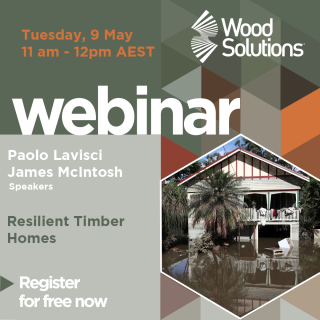WoodSolutions Webinar | Resilient Timber Homes


In our opinion the timber should be suitable to remain in service. Wood rot is unlikely in timber treated with creosote, although we weren't sure whether it was a pressure treatment or a brush-on application. In any event, once timber is fully dry (and kept dry) decay fungi cannot attack timber.To determine when it is fully dry, testing with a moisture meter would be helpful. The aim would be to bring the moisture content down to 12% or below. This should be achieved before new wall linings are installed.
A Fire Resistance Level (FRL) of 90/-/- means only structural adequacy needs to be considered, and this must be maintained for 90 mins. Australian Standard 1720, Timber Structures, Part 4: Fire resistance for structural adequacy of timber members, provides an assessment method based on the density of the timber and its charring rate when exposed to fire. The formula for the "notional charring rate" is given as
Our Technical Design Guide #05 is focused mainly on the service life of timber outdoors, in-ground or above-ground, and/or in situations where it needs termite protection. Generally speaking, timber indoors that is kept dry (therefore can't rot) and protected from termites (necessary everywhere in Australia except Tasmania) has an unlimited service life, even without H1 treatment. Consequently, the predicted 50+ service life is somewhat conservative. The exception is in Western Australia where the European House Borer has been a problem.
The requirement for 2, 3 or 4 jamb studs in Table 11 of the AS 1684.2 Supplements applies to both sides of the opening. Clause 6.3.2.3 will be helpful in explaining how the studs are distributed, in conjunction with Fig. 6.9. For example, where 4/90 x 45 jamb studs are required 2 are to be full length studs, and 2 are to be secondary jamb studs, each side of the opening. As stated in Clause 6.3.2.3, 2 secondary jamb studs may be required where the lintel tables "require bearing lengths greater than that provided by the [single] secondary jamb stud".
Timber doesn't have a specific stress grade until it has been through a grading process, either by visual or mechanical means. Consequently, our webpage displays the five possible stress grades for sugar gum, as shown under the "Properties" tab. The grade applicable to a parcel of timber will depend on its quality, ie. the size and position of knots, slope of grain and other factors, all of which are taken into account in the grading process. Also the range of achievable grades varies according to whether the timber is seasoned or unseasoned.
Are you looking for a supplier?